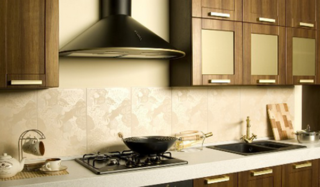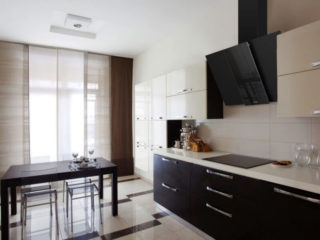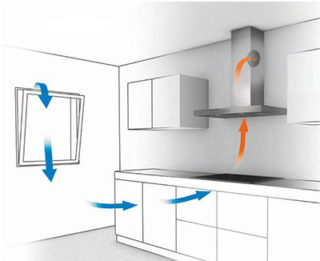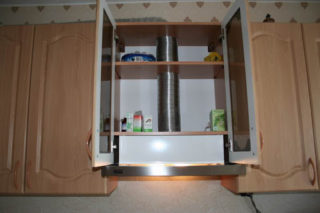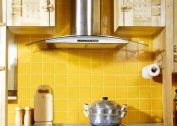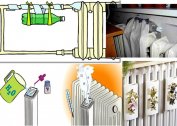The kitchen has a difficult microclimate, and people are often in it. The kitchen is used for cooking, breakfast, lunch and dinner, spending time with the family. It is important that the air in the kitchen is clean and fresh without any unpleasant odor. A hood will help to clean the air masses.
Arguments for and against the installation
The need for air purification is established by hygienic requirements, the observance of which is mandatory for maintaining the health of residents of the house and apartment. During cooking, fat, dirt, unpleasant odor appear in the air masses, which are harmful to human health. For effective cleaning of air flows, hoods are used.
An old-style device takes up a lot of space, which is especially not enough in small-sized apartments in Khrushchev. Modern models are able to complement the design of the room.
The main arguments against installing an exhaust system include:
- Efficiency of cleaning using a ventilation system without the use of additional products.
- Health risks due to settling of grease and dirt on filters. Such an environment becomes ideal for the propagation of microbes and pathogenic bacteria. But when carrying out timely replacement and cleaning, the hood does not pose a threat to health.
- Noise.
Manufacturers have already eliminated many of the negative properties associated with the technical features of the device (sound, vibration). Noise standards in high-quality devices do not exceed the established values. The aesthetic issue can also be considered resolved thanks to a wide range of the most diverse models in shape and size. Modern hoods can be built into furniture, which is why they practically do not take up space.
Device purpose
To understand whether a hood is needed in the kitchen, you should understand its functions. The main benefit is to clean the air from pollution and unpleasant odors. Thanks to the circulation of air masses in the kitchen, it will always be fresh even after cooking fatty dishes.
Modern appliances are equipped with lamps on the bottom surface. This allows you to further highlight the workspace. In the evening, you will not need to turn on the main lighting in the room.
The range of exhaust systems is wide, so you can find a device suitable for any interior and at any power.
Built-in appliances will not be visible to the eye at normal times. For a while, the surface extends and effectively performs its functions.
Varieties of hoods
According to the principle of functioning, two types of hoods are distinguished - recirculation and flow hoods. The first type filters the air and purifies it from pollution, and the second takes it out onto the street.
Flow-through designs are more efficient and able to cope with a large volume of air per unit time than recirculation ones. They are recommended to be placed for those who often cook fatty foods. Installation is complicated and requires a specialist call to connect to the ventilation system of the house. Installation of an anti-return valve is also required so that polluted air flows do not return to the apartment.
Recirculation devices are compact and easy to install. Functionality is limited.They cannot save from an unpleasant odor, as air passes through the filters and comes back. Filters also require periodic cleaning and replacement.
The design of the device is different. The main types on the market include:
- Built-in appliances with a retractable working panel. These are more expensive hoods that are equipped with additional features. They take up little space, are compact, multifunctional and fit organically into the interior. Thanks to installation in a box they are not visible.
- Outboard. Usually these are recirculation models, flowing ones are less common. They look like a flat panel that is attached to the bottom of a wall cabinet. Handle a limited amount of air. Compact, therefore often used in small kitchens.
- Island. These are the most powerful installations that purify the air throughout the house. They can be installed anywhere.
- Dome. Mounted on a wall or ceiling. Usually flow type. The height of the dome can reach 125 cm, which must be considered before installing the equipment in the kitchen.
Depending on how the kitchen is used and how much space is in it, a suitable model is selected.
Advantages and disadvantages
To finally determine the need for hoods in the kitchen, you need to familiarize yourself with the positive and negative sides. The kitchen without a hood over the stove has the following advantages:
- Stylish laconic design of the room, which is not burdened by unnecessary equipment.
- More free space. This is especially true for small apartments.
- The absence of additional noise that emits a working device.
- No care for an additional household appliance required.
- Lower electricity costs.
In the absence of a hood, the landlord will encounter the following problems:
- The ventilation duct will not be able to fully remove odors from the kitchen.
- Grease and soot will settle on the ceiling, soak into clothing and furniture. It’s difficult to remove some odors.
- Permanent natural ventilation will be required. In the cold season, unnecessarily opening a window can lead to drafts and the risk of illness for family members. Also, houseplants will respond to sudden changes in temperature.
- Frequent general cleaning is required to remove the yellow film from furniture, walls and ceiling.
- Quick pollution of wallpaper, curtains, ceiling finishes.
- No harmful carbon monoxide is removed, which negatively affects people's health.
The disadvantages of the lack of hoods are much greater, many of them are associated with a threat to health. It is better to sacrifice extra space in the kitchen and interior to keep the air clean.
When you can not use the hood
Despite the importance of such equipment, there are cases where the hood can be omitted. If the kitchen is not used for cooking, but serves as a dining room, it does not form unnecessary fumes and odors. Also, the installation of the hood can be neglected if a powerful fan is installed in the house. It effectively removes all the fumes and odors that are formed during cooking.
In the case of installing a modern stove in the house, during the work of which carbon monoxide is not emitted, it is possible not to install a hood. Normal ventilation or good ventilation is sufficient to remove odors.
Option for small kitchens
The optimal solution for small premises is the use of built-in household appliances. The hood, which is installed in the closet, does not harm the appearance of the room and does not take up much space. The positive qualities of such devices include:
- Compact dimensions.Due to the presence of a retractable working part, free space will be saved at normal times, which is especially important in small studio apartments.
- Thanks to integration into the cabinet, a careful selection of the device for the interior is not required.
- Additional functions.
There is one drawback: cost. It is higher than that of classic suspended models. But the price is justified by wide functionality and minimal installation dimensions.
